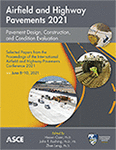Performance Characteristics of Asphalt Mixes Containing High Percentage of RAP Material
Publication: Airfield and Highway Pavements 2021
ABSTRACT
Major challenges of using reclaimed asphalt pavement (RAP) in asphalt pavement are the stiffness of RAP because of oxidation of asphalt binder with the age and lack of performance data containing a high percentage (>30%) of RAP in hot mix asphalt (HMA). This research paper is aimed to investigate the feasibility of high percentage 60% RAP in asphalt mixes in the surface course of pavement. Designed mixes were developed for control mix and RAP mixes with two different rejuvenators to evaluate the performance parameters like indirect tensile strength, susceptibility to moisture damage, stiffness, cracking resistance, rutting, and fatigue. From the study, it is concluded that RAP mix with tall oils rejuvenator was better in terms of moisture resistance and rutting performance, while RAP mix with aromatic extract rejuvenator was better in terms of fatigue cracking. However, fatigue performance was better in control mix than RAP mixes.
Get full access to this article
View all available purchase options and get full access to this chapter.
REFERENCES
A. A. Mamun, and H. I. Al-Abdul Wahhab. (2018) “Evaluation of Waste Engine Oil-Rejuvenated Asphalt Concrete Mixtures with High RAP Content” published in Hindawi, Advances in Materials Science and Engineering Volume 2018, Article ID 7386256, 8 pages https://doi.org/10.1155/2018/7386256.
Ahmad Kamil Arshad, Haryati Awang, Ekarizan Shaffie, Wardati Hashim, and Zanariah Abd Rahman. (2018) Performance Evaluation of Hot Mix Asphalt with Different Proportions of RAP Content EDP Sciences.
I. L. Al-Qadi, M. Elseifi, and S. H. Carpenter. (2007), “Reclaimed Asphalt Pavement- A Literature Review”, Illinois Centre for Transportation.
ASTM D 2172. Standard Test Methods for Quantitative Extraction of Asphalt Binder from Asphalt Mixtures, American Society for Testing and Materials.
ASTM D 4123. Standard Test Method for Indirect Tension Test for Resilient Modulus of Bituminous Mixtures, American Society for Testing and Materials.
ASTM D 4867. Standard Test Method for Effect of Moisture on Asphalt Concrete Paving Mixtures, American Society for Testing and Materials.
ASTM D 6931. Standard Test Method for Indirect Tensile (IDT) Strength of Asphalt Mixtures, American Society for Testing and Materials.
ASTM D 6931. Standard Test Method for Determining the Resilient Modulus of Bituminous Mixtures by Indirect Tension Test, American Society for Testing and Materials.
ASTM D 7870. Standard Practice for Moisture Conditioning Compacted Asphalt Mixture Specimens by Using Hydrostatic Pore Pressure, American Society for Testing and Materials.
J. A. Epps, D. N. Little, R. J. Holmgreen, and R.L. Terrel. (1980). “Guidelines for Recycling Pavement Materials”, Transportation Research Board, Washington, DC.
G. M. Harun-Or-Rashid, Bulbul Ahmed, Mohd. Abdus Sobhan, and Nafiur Rahman. (2018), Marshall Characteristics of Bituminous Mixes Using Reclaimed Asphalt Pavement, American Journal of Traffic and Transportation Engineering. Vol. 3, No. 4.
J. Richard Willis, Pamela Turner, Grant Julian, Nam Tran, and Flavio de Goes Padula. (2013), “Alternative Methods for Increasing the Durability of RAP Mixtures”, Auburn University, US.
Jashanjot Singh, and A. K. Duggal. (2015) “An Experimental Study on Reclaimed Asphalt Pavement in Bituminous Concrete”, International Journal of Modern Trends in Engineering and Research (IJMTER) Volume 02, Issue 08.
Junan Shen, and Yoshio Ohne. (2002) “Determining Rejuvenator Content for Recycling Reclaimed Asphalt Pavement” by SHRP Binder Specifications, International Journal of Pavement Engineering, 3:4, 261-268.
Martins Zaumanis, and Rajib B. Mallick. (2014) “Evaluation of different recycling agents for restoring aged asphalt binder and performance of 100 % recycled asphalt” Article in Materials and Structures https://link.springer.com/article/10.1617/s11527-014-0332-5.
McDaniel Rebecca, and R. Michael Anderson. (2001) “Recommended Use of Reclaimed Asphalt Pavement in the Superpave Mix Design Method: Technician’s Manual” Transportation Research Board, National Academy Press Washington, D.C.
MoRTH. (2013). Ministry of road transport and highways. Specifications for Road and Bridge Works, 5th Revision, Indian Roads Congress, New Delhi, India.
MS-2 The Asphalt Institute Manual Series No. 2. Mix design methods for asphalt concrete and other hot-mix types, 7th (2014), Asphalt Institute, USA.
MS-20 The Asphalt Institute Manual Series No. 20. Asphalt Hot Mix Recycling, Second Edition (1986), Asphalt Institute, USA.
Nam Tran, Adam Taylor, Pamela Turner, Christopher Holmes and Laurent Porot. (2017) “Effect of Rejuvenator on Performance Characteristics of High RAP Mixture” published in journal Road materials and Pavement Design, Volume 18 https://doi.org/10.1080/14680629.2016.1266757.
D. Newcomb, E. R. Brown, and J.A. Epps. (2007). Quality Improvement Series 124: Designing HMA Mixtures with High RAP Content: A Practical Guide, National Asphalt Pavement Association, Lanham, MD, US.
Ram Kumar Veeraragavan. (2016) “An Investigation of the Performance of Hot Mix Asphalt (HMA) Binder Course Materials with High Percentage of Reclaimed Asphalt Pavement (RAP) and Rejuvenators”, A report submitted to the Faculty of the Worcester Polytechnic Institute, MA, US.
Rebecca McDaniel, and R. Michael Anderson. (2001) “Recommended Use of Reclaimed Asphalt Pavement in the Superpave Mix Design Method: Guidelines”, Transportation Research Board, Washington, DC.
Robert Karlsson1, and Ulf Isacsson. (2006) “Material related aspects of Asphalt Recycling”, Journal of Materials in Civil Engineering © ASCE.
Rouzbeh Ghabchi, Dharamveer Singh, Musharraf Zaman, and Zahid Hossain. (2015) “Laboratory characterisation of asphalt mixes containing RAP and RAS” International Journal of Pavement Engineering Vol. 17, No. 9, 829–846, https://doi.org/10.1080/10298436.2015.1022778.
Taleb Al-Rousan, Ibrahim Asi, Omar Al-Hattamleh, and Husam Al-Qablan. (2008), “Performance of Asphalt Mixes Containing RAP”, Jordan Journal of Civil Engineering, Volume 2, No. 3.
V. Garcia, A. Miramontes, J. Garibay, I. Abdallah, and S. Nazari. (2017) Improved Overlay Tester for Fatigue Cracking Resistance of Asphalt Mixtures, Conducted for Texas Department of Transportation.
Walaa S. Mogawer, Ellie H. Fini, Alexander J. Austerman, Abbas Booshehrian, and Boubacar Zada. (2015), “Performance characteristics of high reclaimed asphalt pavement containing bio-modified”, Road Materials and Pavement Design, 2016 Vol. 17, No. 3.
Information & Authors
Information
Published In
Copyright
© 2021 American Society of Civil Engineers.
History
Published online: Jun 4, 2021
Authors
Metrics & Citations
Metrics
Citations
Download citation
If you have the appropriate software installed, you can download article citation data to the citation manager of your choice. Simply select your manager software from the list below and click Download.
